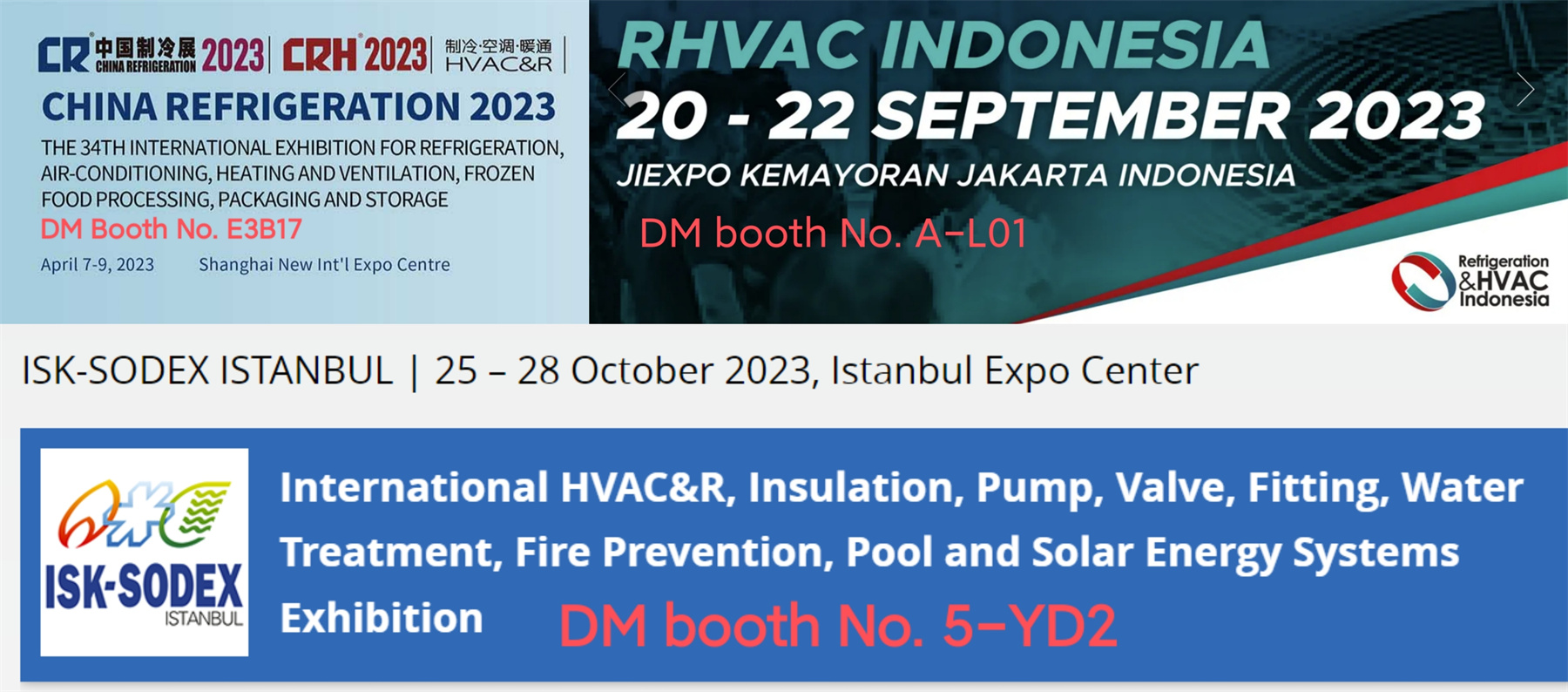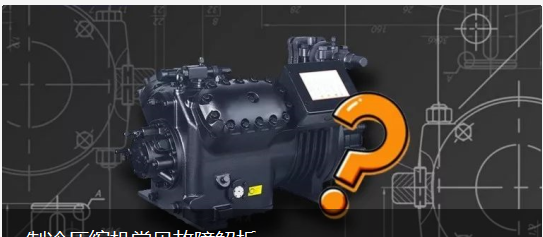1. Suction temperature is high
Excessively high suction temperature is mainly due to increased suction superheat. Note: A high suction temperature does not mean that the suction pressure is high because it is superheated steam. Usually, the cylinder head of the compressor should be half cold and half hot. If the intake temperature is too high, the cylinder head will heat up. If the suction temperature is higher than the fixed value, the exhaust gas temperature will rise accordingly.
The reason:
a. The refrigerant is insufficient. Even if the expansion valve work maximumly, there is no change in the liquid supply, that the refrigerant temperature is high in the evaporator so that raising the suction temperature.
b. The expansion valve work in less capacity. The circulation of the refrigerant of the system is insufficient, less refrigerant enter into the evaporator ,higher superheat , higher suction temperature.
c. The expansion valve’s filter is clogged. The amount of liquid supply in the evaporator is insufficient, the amount of refrigerant liquid is reduced, and a part of the space of evaporator is occupied by superheated steam, so the intake air temperature is increased.
d. other reasons.
-
2. The suction temperature is too low – it is likely that the evaporator liquid over supply and the suction superheat is low.
a. The refrigerant charge is too much, occupying a part of space inside of the condenser, so that the condensing pressure is high, and the liquid entering the evaporator is increased. The liquid in the evaporator cannot be completely vaporized, so that the gas sucked by the compressor contains liquid droplets. Thus, the temperature of the return air duct cooling down, but the evaporating temperature does not change because the pressure does not decrease, and superheat decreases. Even if adjust expansion valve, there is no much improvement.
b. The opening degree of the expansion valve is too large. Because the temperature sensor is loosely tied, the contact area with the return air pipe is small, or the temperature sensor is not wrapped with the heat insulating material and the wrapping position is wrong, the temperature measured by the temperature sensor is inaccurate, close to the ambient temperature, and the expansion valve is operated. The degree of opening increases, resulting in too much liquid supply.
The reason:
The refrigerant charge is insufficient and will be frozen from the evaporator to the compressor (Note: need to be verified). In addition, due to external reasons, the refrigerant does not evaporate good or even not evaporate at all in the evaporator, which may cause severe frosting or even compress wetly. (If the central air-conditioning returns to the air badly or the air-conditioning filter is seriously blocked, the pipe of chiller will be frozen and the exhausting temperature is very low.) The pipe is not well insulated or the pipe is too long, which can cause air suction temperature high.
3. Exhaust temperature is abnormal
Potential factors: adiabatic value, compression ratio, suction temperature.
The compressor discharge temperature can be read from a thermometer on the exhaust line. It is related to the adiabatic index of the refrigerant, the compression ratio (condensation pressure/evaporation pressure), and the suction temperature. The higher the suction temperature, the higher the compression ratio and the higher the exhaust temperature.
When the suction pressure is constant, the exhaust gas temperature rises when the exhaust pressure increases; if the exhaust pressure does not change, the exhaust gas temperature also rises when the suction pressure reduced, both of which are due to an increase in compression ratio. Excessive condensing temperatures and exhaust temperatures are detrimental to the operation of the compressor and should be avoided. Excessively high exhaust temperatures can cause the lubricating oil to become thinner or even charred and coke, which deteriorates the lubrication conditions of the compressor.
The temperature of the exhaust gas is proportional to the compression ratio (condensation pressure / evaporation pressure) and the suction temperature. If the superheat of the suction temperature is high and the compression ratio is high, the exhaust gas temperature will be high. If the suction pressure and temperature do not change, the exhaust gas temperature also rises as the exhaust pressure increases.
The main reasons of increase in discharging temperature
a. higher suction temperature. After refrigerant vapor being compressed and the exhaust temperature is higher.
b. The condensing temperature rises up so that condensing pressure is high,too. causing the displacement temperature to rise.
c. The exhaust valve plate is crushed, the high pressure steam is repeatedly compressed and the temperature rises, the cylinder and the cylinder head are hot, and the thermometer indication value on the exhaust pipe also rises.
The actual factors affecting the rise of the displacement temperature are: the intermediate cooling efficiency is low, or the excessive scale in the intercooler affects the heat exchange, the suction temperature of the latter stage is necessarily high, and the displacement temperature is also increased. The gas valve leaks and the piston ring leaks, which not only affects the rise of the displacement temperature, but also changes the interstage pressure. As long as the compression ratio is higher than the normal value, the displacement temperature will rise. Daming Refrigeration reminds you that water-cooled machines lack water or insufficient water will increase the exhaust temperature. The condensing pressure is abnormal and the exhaust pressure is lowered.
4.high exhaust pressure
The exhaust pressure is generally related to the level of the condensing temperature. Under normal conditions, the compressor discharge pressure is very close to the condensing pressure. High exhaust pressure will increase the compression power and reduce the gas transmission coefficient, thus reducing the cooling efficiency.
As the condensing pressure increases, the compressor discharge temperature also rises. The compression ratio of the compressor is increased, and the gas transmission coefficient is reduced, so that the refrigeration capacity of the compressor is lowered. The power consumption has increased. If the exhaust gas temperature is too high, the consumption of the compressor lubricating oil is increased, the oil is thinned, and the lubrication is affected; when the exhaust gas temperature is close to the flash point of the compressor oil, part of the lubricating oil is carbonized and accumulated in the suction, The exhaust valve port affects the sealing of the valve.
Reducing the temperature of the cooling medium can cause the condensation temperature to drop and the condensation pressure to decrease, but this is limited by environmental conditions and is difficult to choose. Increasing the flow rate of the cooling medium reduces the condensation temperature (this method is used more). However, it is not possible to increase the flow of cooling water or air unilaterally, as this will increase the power of the cooling water pump or fan and the motor, and should be comprehensively considered.
5. insufficient exhaust
Insufficient displacement – mainly compared to the designed displacement of the compressor, is one of the most prone to failures of the compressor, mainly due to several reasons:
1. The intake filter is fouled or the compressor suction pipe is too long, and the pipe diameter is too small, which causes the suction resistance to increase, which affects the intake air volume and reduces the exhaust gas volume.
2. The compressor speed is reduced to reduce the exhaust volume. Since the displacement of the compressor is designed according to a certain altitude (mainly air compressor), intake temperature, humidity and power supply, when it is used in an environment exceeding the above standard, such as air compressor are used in the plateau will cause the suction pressure to decrease, etc., and the displacement will also be affected.
3, the packing seal is not strict, resulting in leakage, so that the exhaust volume is reduced. First of all, it may be that the filler itself is not qualified; secondly, it may be caused by air leakage during installation, such as abrasion or strain. Generally, the filler is filled with lubricating oil, which can be lubricated, sealed and cooled.
Send your message to us:
Post time: Aug-20-2019








